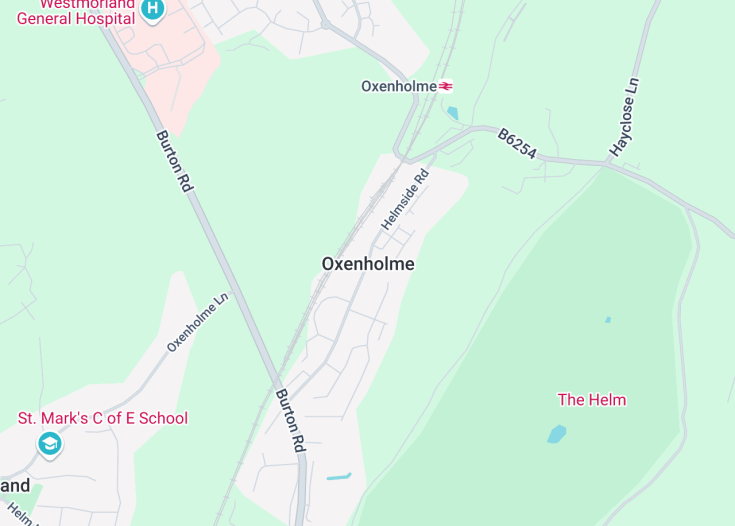Oxenholme, nestled in the beautiful county of Cumbria in England, serves as a vital gateway to the enchanting Lake District. Primarily known for its railway station, Oxenholme Lake District, this charming village not only connects major cities but also offers visitors a taste of serene countryside life.
Rich in scenic beauty and tranquility, it is an ideal starting point for explorers eager to delve into the majestic landscapes of the Lakes or visit nearby historic towns.
When visiting Oxenholme, consider planning your train journeys in advance to avoid peak times, ensuring a more relaxed and enjoyable travel experience.
To enhance your visit, explore the local walking trails that start near the station, providing a direct route into the heart of the Lake District’s stunning natural beauty.
Top things to do & see in Oxenholme
Select the following sights and activities to discover best tickets and tours available in Oxenholme.
Oxenholme: The Gateway to the Lakes
| Country | England (United Kingdom) |
| Time in Oxenholme | GMT+0 |
| Language spoken | English |
| Population | 5,402 (source: Latest Census) |
| Currency | Pound Sterling (£, GBP) |
| Airports |
|
Located in the historic county of Westmorland, Oxenholme is a quintessential English village often touted as the gateway to the scenic Lake District. With its picturesque landscapes and tranquil atmosphere, the village welcomes thousands of nature lovers each year, eager to explore the surrounding countryside and nearby attractions like Lake Windermere and Sizergh Castle. Oxenholme is notably less crowded compared to other Lake District haunts, offering a more secluded and authentic rural England experience.
The village’s name, ‘Oxenholme,’ hints at its pastoral beginnings, believed to be derived from a homestead associated with oxen. This rural heritage continues to influence the village character, evident in well-preserved ancient buildings and traditional celebrations. The community is tightly-knit, with local shops and traditional pubs centering the social scene, and events like the annual Oxenholme Country Fair drawing crowds from across the region.
Oxenholme is also well-known for its transport links, housing Oxenholme Lake District Railway Station, a major junction on the West Coast Main Line. This accessibility makes it a favored starting point for many venturing into the deeper parts of the Lake District. Despite its small size, the village’s strategic location has allowed it to play a vital role in regional connectivity.
Where is Oxenholme?
Oxenholme lies in the heart of Cumbria in North West England, surrounded by the natural beauty of the Lake District National Park.
Distances:
| Route | Distance by car | Time by car |
|---|---|---|
| Oxenholme to London | 261 miles | Approx. 4 hours 20 mins |
| Oxenholme to Manchester | 85 miles | Approx. 1 hour 25 mins |
| Oxenholme to Birmingham | 160 miles | Approx. 2 hours 45 mins |
What is Oxenholme famous for?
Oxenholme is renowned as a crucial hub for railway travelers heading to the Lake District, offering pivotal connectivity and scenic train journeys highlighting England’s lush landscapes.
History
Pre-19th Century
Oxenholme, now a quaint village nestled in the Kendal district of Cumbria, England, has a historical tapestry that dates back to ancient times, although detailed records from these early periods are sparse. The area around Oxenholme was likely inhabited by Celtic tribes before the Roman occupation of Britain and subsequently influenced by Norse settlers, as indicated by the etymology of nearby place names and archaeological findings.
19th Century – The Advent of the Railway
The most significant development in Oxenholme’s history came with the advent of the railway in the 19th century. The construction of the Oxenholme railway station in 1846 as a part of the Lancaster and Carlisle Railway transformed this small hamlet into a critical junction point. The station connected Oxenholme to larger economic hubs, notably facilitating outreach to Scotland and further promoting local economic development.
20th Century to Present
Moving into the 20th century, Oxenholme continued to prosper modestly, maintaining its status primarily as a railway village. The area around Oxenholme remained largely agricultural, with the village’s life rhythm dictated by the comings and goings of trains. Today, Oxenholme maintains its charm as a tranquil getaway, with its history intimately connected to the railways, serving as a portal to the scenic Lake District and offering a glimpse into England’s industrious age.
Visit Oxenholme
What to see and do in Oxenholme, England
Oxenholme, often appreciated for its quaint rural charm and proximity to natural landscapes, offers several attractions:
- The Oxenholme Lake District Railway Station, a historical structure pivotal to the village’s development.
- Close proximity to Kendal, allowing visitors to explore medieval Kendal Castle and the Kendal Museum.
- Access to walking and biking trails in the scenic Lake District National Park.
Additionally, Oxenholme serves as the perfect base for venturing into the Lake District for hiking, rambling, and boating activities.
Annual Events in Oxenholme
Oxenholme, while small, participates actively in regional events, most notably linked to the broader cultural activities of the Lake District area. Visitors can enjoy various seasonal festivals and fairs, especially during the summer months, which celebrate local history, music, and crafts.
Best time to visit Oxenholme
The ideal time to visit Oxenholme is from late spring to early autumn (May through September), when the weather is most favorable for outdoor activities like trekking and exploring the countryside, aligning with the peak festivities in and around the Lake District.
Is Oxenholme worth visiting?
Oxenholme, with its historical significance tied to Britain’s railway expansion and its proximity to the Lake District, offers a unique combination of cultural heritage and natural beauty.
It is indeed worth visiting for those interested in English railway history or looking for a serene gateway to explore the lush landscapes and vibrant cultural scene of the Lake District.










